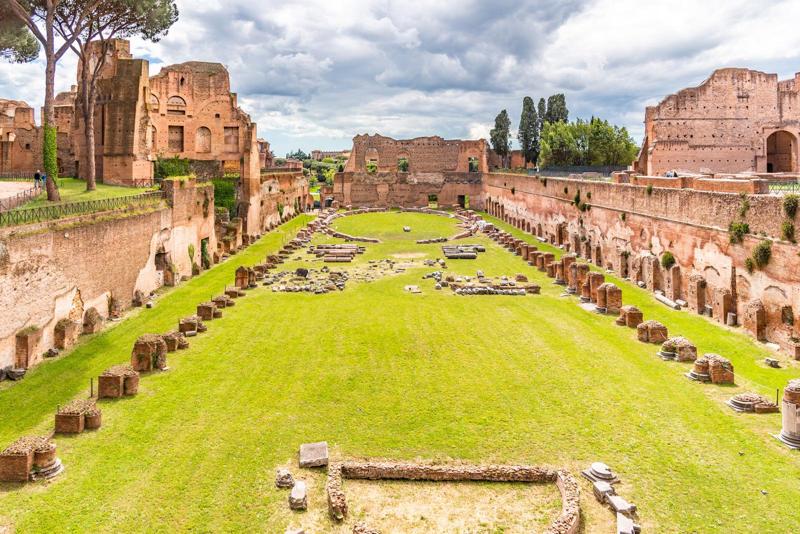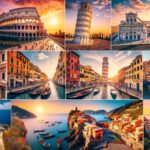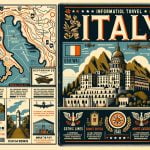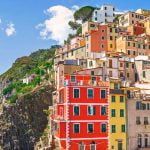Rome, Italy is a city steeped in history, culture, and breathtaking beauty. Known as the Eternal City, Rome has captivated travelers for centuries with its iconic landmarks and rich heritage. Whether you’re an art lover, history buff, or simply seeking a vibrant and enchanting destination, Rome has something for everyone. In this article, we will explore the top travel sites in Rome that should not be missed during your visit to this remarkable city.
One cannot mention Rome without acknowledging its extraordinary history and cultural significance. From ancient ruins to magnificent churches and monuments, Rome is a living testament to the legacy of civilizations past. Walking through the streets of this majestic city feels like stepping back in time as you encounter iconic landmarks such as the Colosseum, Roman Forum, and Pantheon.
The allure of Rome lies not only in its historical treasures but also in its vibrant atmosphere and modern-day charms. The city seamlessly blends ancient wonders with cosmopolitan flair, offering visitors a unique experience at every turn. Whether you find yourself tossing a coin into the Trevi Fountain or savoring authentic Italian cuisine in Trastevere’s quaint cobblestone streets, Rome promises to leave an indelible mark on your heart.
As we embark on this journey through the Eternal City together, we will delve into each travel site’s rich historical background and uncover hidden secrets that make these locations truly remarkable. From exploring Vatican City’s spiritual oasis to immersing yourself in the bohemian charm of Trastevere, each section will provide valuable tips and insights to help you make the most out of your visit to these iconic destinations.
So pack your bags and get ready to discover unforgettable travel sites in Rome that will leave you awe-inspired and yearning for more.
Colosseum
The Colosseum, also known as the Flavian Amphitheatre, stands as a symbol of ancient Rome’s grandeur and power. Located in the heart of the city, this iconic structure attracts millions of visitors each year who come to witness its ancient glory.
Built between 70-80 AD, the Colosseum was originally used for gladiatorial contests, animal hunts, and other spectacles that entertained the citizens of Rome. The amphitheater could hold up to 50,000 spectators and was a marvelous display of Roman engineering and architecture. Its elliptical shape and numerous arches are not only visually stunning but also highlight the advanced construction techniques employed by the Romans.
Today, the Colosseum is one of Rome’s most popular tourist attractions, drawing history enthusiasts from all over the world. Visitors can explore its underground chambers where gladiators once prepared for battle or take a guided tour to learn about the complex mechanisms that made the spectacles possible. Admiring the impressive ruins from both inside and outside is an unforgettable experience that allows travelers to step back in time and imagine what life was like during ancient Rome.
Here are some essential tips for visiting the Colosseum:
- Purchase tickets in advance: Due to its popularity, it is advisable to buy tickets online or at least arrive early to avoid long queues.
- Guided tours: Consider joining a guided tour for a more immersive experience. Knowledgeable guides can provide fascinating insights into the history and construction of this ancient wonder.
- Comfortable footwear: The Colosseum involves a lot of walking, so wearing comfortable shoes is crucial. Additionally, be aware that there are stairs involved when exploring different areas within the amphitheater.
| Colosseum Facts | Data |
|---|---|
| Construction Period | 70-80 AD |
| Capacity | 50,000 spectators |
| Architectural Style | Roman architecture |
| Ticket Information | Purchase tickets in advance or arrive early to avoid long queues. Consider joining a guided tour for a more immersive experience. |
Visiting the Colosseum is like stepping back in time, allowing travelers to witness the ancient glory of Rome. Its architectural grandeur and historical significance make it an essential destination for anyone exploring the Eternal City.
Vatican City
Located within the boundaries of Rome, Vatican City is not only the world’s smallest independent state but also a spiritual and artistic oasis that attracts millions of visitors each year. Home to magnificent architectural masterpieces and priceless works of art, Vatican City offers a unique blend of religious significance and cultural wonders.
Exploring the Vatican Museums is a must for any visitor to Vatican City. With its vast collection spanning over 9 miles, the museums are a treasure trove of artistic marvels. From ancient sculptures to Renaissance paintings, visitors can immerse themselves in centuries of artistic expression. The highlight of the Vatican Museums is undoubtedly the Sistine Chapel, where they can gaze up at Michelangelo’s breathtaking frescoes on its famous ceiling and Last Judgment wall.
To fully experience Vatican City, one should not miss St. Peter’s Basilica. This colossal church holds great religious importance as it is considered one of Catholicism’s holiest shrines. The intricate detail and sheer grandeur found inside St. Peter’s Basilica are awe-inspiring, from Bernini’s breathtaking Baldacchino to Michelangelo’s Pietà statue.
For those looking for a truly memorable experience, attending a Papal Audience at St. Peter’s Square can provide an intimate glimpse into the Catholic faith while witnessing Pope Francis delivering blessings and teachings to pilgrims from all around the world.
Navigating Vatican City can be overwhelming due to its immense size and popularity among tourists. To make the most out of your visit, it is advisable to plan ahead and book tickets online to avoid long queues. Additionally, hiring a knowledgeable tour guide can enhance your visit by providing you with fascinating insights into the history and significance of the various attractions within Vatican City.
Overall, Vatican City offers travelers an unparalleled experience exploring both spiritual and artistic wonders in one unique setting. Whether you’re seeking religious enlightenment or simply want to admire the sheer beauty of some of humanity’s greatest achievements, Vatican City is a destination that will leave a lasting impression on all who visit.
Roman Forum
As one stands in the sprawling ruins of the Roman Forum, it is impossible not to feel a sense of awe and wonder as centuries of history unfold before their eyes. Known as the “heart” of ancient Rome, the Roman Forum was once a bustling center of political, religious, and commercial activity. Today, it stands as a vast archaeological treasure, offering visitors a glimpse into the grandeur and power of ancient Rome.
The Roman Forum is home to numerous ruins, temples, and important structures that provide insight into daily life in ancient Rome. As visitors explore this historical site, they can walk along the Via Sacra (Sacred Way) and imagine themselves surrounded by bustling crowds and lively markets.
Among the most iconic landmarks within the Roman Forum are the Temple of Saturn, dedicated to the god of agriculture; the Arch of Titus, commemorating Emperor Titus’ triumph over Jerusalem; and the impressive remains of Basilica Aemilia.
To fully appreciate and understand the historical importance of this magnificent site, here are some tips for exploring the Roman Forum:
- Guided Tours: Consider joining a guided tour to make the most out of your visit. Expert guides can provide valuable insights into each structure’s significance and bring history to life.
- Plan Ahead: The Roman Forum is vast, so it’s essential to plan your visit carefully. Prioritize key sites you want to see based on your interests and allocate enough time for exploration.
- Important Landmarks: Some must-see landmarks within the Roman Forum include Julius Caesar’s burial site at The Temple of Caesar, The House of Vestals – where vestal virgins resided – , and The Rostra – an elevated platform from which speeches were delivered.
- Visit Palatine Hill: Since Palatine Hill is located adjacent to the Roman Forum, consider visiting both sites together. Palatine Hill offers stunning views of the Forum and provides additional ruins and insights into ancient Roman life.
As visitors unravel the secrets of ancient Rome within the Roman Forum, they gain a deeper understanding of the political, cultural, and architectural achievements of this once-mighty civilization. Exploring this archaeological treasure is truly a journey through time, immersing oneself in the stories woven between the crumbling columns and weathered stones.
Pantheon
The Pantheon in Rome is a testament to the remarkable engineering feats of ancient Roman architecture. This iconic structure has stood the test of time and continues to awe visitors with its grandeur. From its unique dome to its magnificent interior design, the Pantheon remains one of the most impressive sites in Rome.
One of the most fascinating aspects of the Pantheon is its dome, which stands as the largest unreinforced concrete dome in the world. The dome’s design ingeniously distributes weight and reduces stress on the walls, allowing it to maintain its structural integrity for over 2,000 years. Its perfect hemispherical shape creates a sense of harmony and balance that adds to its aesthetic appeal.
Inside the Pantheon, visitors are greeted by an expansive space known as the rotunda. The beauty lies in both simplicity and complexity – from the precise geometry of its floor plan to the oculus at its center.
The oculus is a circular opening in the roof that lets in natural light, creating a mesmerizing beam that moves with the sun’s position throughout the day. This architectural element not only adds to the grandeur but also enhances the spiritual atmosphere within.
When visiting the Pantheon, there are some must-know facts and lesser-known secrets that can enrich your experience. For instance, did you know that it was originally built as a temple dedicated to all gods? This rich history adds depth to your exploration of this ancient temple. Additionally, take note that entry is free for all visitors, making it an accessible site for everyone.
To make sure you get the most out of your visit to the Pantheon, consider these tips:
- Arrive early or during off-peak hours to avoid crowds.
- Take a moment to sit on one of the benches and soak in your surroundings.
- If you’re lucky, you may catch a performance or concert held within the majestic walls of the Pantheon.
- Take a closer look at the marble floor, as it contains small holes that act as drainage for rainwater entering through the oculus.
All in all, witnessing the Pantheon is an experience that will leave you in awe of ancient Roman architecture and engineering prowess. Its magnificence is truly a marvel to behold, making it a must-visit travel site in Rome.
Trevi Fountain
The Trevi Fountain, located in the Quirinale district of Rome, is undoubtedly one of the most iconic landmarks in the city. It serves as a symbol of romance, wishes, and dolce vita, capturing the imagination of visitors from around the world. The fountain’s intricate design and fascinating mythology make it a must-see attraction for anyone visiting Rome.
The Mythology Behind the Trevi Fountain
According to ancient Roman legend, throwing a coin into the Trevi Fountain ensures that you will return to Rome someday. This tradition has become synonymous with the fountain itself and attracts millions of visitors each year. But why is this practice so popular?
The tradition dates back to ancient times when people would throw coins into bodies of water as an offering to the gods in hopes of receiving their favor. In this case, throwing a coin into the Trevi Fountain was believed to not only guarantee a return trip but also bring good luck and fortune.
The Intricate Design of the Trevi Fountain
The grandeur and beauty of the Trevi Fountain lie not only in its mythology but also in its exquisite design. The fountain stands at an impressive height of 85 feet and spans over 65 feet wide, making it one of Rome’s largest fountains. Its architecture is a captivating blend of baroque and classical styles, designed by renowned Italian architect Nicola Salvi.
At the center of the fountain stands Neptune, god of the sea and water, flanked by two Tritons representing tranquility and waves. The sculptures surrounding Neptune portray various mythical sea creatures such as seahorses and sirens. Every detail is meticulously sculpted, showcasing remarkable craftsmanship.
The Tradition of Tossing a Coin – Is It Worth It?
As mentioned earlier, tossing a coin into the Trevi Fountain is believed to guarantee a return trip to Rome. Many visitors participate in this tradition with hopes of one day coming back to the Eternal City.
While the prospect of such luck and fortune is alluring, it’s important to remember that the coins retrieved from the fountain are collected by the city of Rome and used for charitable purposes. So not only can throwing a coin into the Trevi Fountain be an opportunity to make a wish, but it also contributes to helping those in need.
However, it’s crucial to respect the fountain and its surroundings when participating in this tradition. Visitors should be mindful of their actions and avoid climbing on or damaging any part of the fountain. It’s also essential to keep in mind that preservation efforts are ongoing, so some areas around the fountain may be cordoned off for maintenance purposes.
Visiting the Trevi Fountain is an essential part of any Rome itinerary, offering a magical and unforgettable experience. It’s awe-inspiring both during daylight hours when sunlight dances on its marble surfaces and at night when it is beautifully illuminated. Whether you believe in superstitions or simply appreciate remarkable design, this magnificent symbol of Rome is sure to leave you enchanted.
Spanish Steps and Piazza di Spagna
The Spanish Steps and Piazza di Spagna are two famous landmarks that embody the essence of Italian glamour in the heart of Rome. Situated at the base of the steps is the iconic Barcaccia Fountain, a masterpiece designed by Pietro Bernini and his son Gian Lorenzo Bernini. This monumental staircase consists of 135 steps that lead up to Trinità dei Monti church, offering a stunning view over the city.
The Spanish Steps have been a popular meeting point for locals and tourists alike for centuries. Today, it remains a bustling hub of activity with people socializing, enjoying a gelato, or simply taking in their surroundings. The intricate design and picturesque setting make it a must-visit location for those seeking to experience the charm and elegance that define Italian culture.
Connected to the Spanish Steps is Piazza di Spagna, a vibrant square filled with luxurious boutiques, designer stores, and high-end brands. This elegant shopping district attracts fashion enthusiasts from around the world who come to indulge in retail therapy amidst the Roman atmosphere. Alongside the glamorous shops are charming cafes where visitors can sit back, relax, and soak up the atmosphere while sipping on a cappuccino or indulging in Italian cuisine.
For those looking to explore beyond shopping and dining experiences, Piazza di Spagna offers nearby attractions such as Keats-Shelley House, which pays tribute to British romantic poets and houses their memorabilia. Another notable site is Babington’s Tea Room, an English-style tea room that has been serving high tea since 1893 – a unique blend of British tradition in an Italian setting.
Trastevere
Venturing off the beaten path in Rome, Italy brings you to the enchanting district of Trastevere. Located on the west bank of Tiber River, Trastevere is a neighborhood that perfectly blends the old and new, offering visitors a taste of authentic Roman atmosphere and culture. With its narrow cobblestone streets, charming piazzas, and local trattorias, it provides a unique experience that is a stark contrast to the tourist-filled attractions found in other parts of the city.
Trastevere has managed to retain its traditional character and charm over the centuries. As you wander through its winding streets, you’ll encounter beautiful Renaissance palaces, medieval churches, and hidden courtyards. One of the must-visit landmarks in this neighborhood is the Basilica di Santa Maria in Trastevere. This stunning church dates back to the 4th century and showcases an impressive mosaic façade that depicts scenes from biblical stories.
In addition to its historical sites, Trastevere is also known for its vibrant nightlife scene. The neighborhood comes alive at night with buzzing bars, live music venues, and cozy wine bars where locals gather to socialize. The Piazza di Santa Maria in Trastevere is particularly lively in the evenings and offers a great spot for people-watching while enjoying a refreshing drink.
When it comes to food, Trastevere does not disappoint. The area is renowned for its delicious Roman cuisine and offers numerous trattorias and osterias where you can indulge in traditional dishes like carbonara or cacio e pepe.
For those looking for a sweet treat after a meal or an afternoon pick-me-up, look no further than Gelateria Fior di Luna. With flavors ranging from classic pistachio to unconventional combinations like ricotta cheese with figs and walnuts, there is something to satisfy every palate.
As a neighborhood that captures the essence of both old and new Rome, Trastevere is a must-visit destination for anyone seeking an authentic experience in the Eternal City. Whether you’re strolling along its ancient cobblestone streets, admiring its historical landmarks, or enjoying a lively night out, Trastevere offers a memorable glimpse into the rich cultural fabric of Rome.
Conclusion
Rome, Italy is a city that truly captivates the hearts of its visitors. With its rich history, cultural landmarks, and undeniable charm, Rome is a must-visit destination for travelers from around the world. Throughout this article, we have explored some of Rome’s most iconic travel sites, each offering a unique glimpse into the city’s storied past.
From the ancient grandeur of the Colosseum to the spiritual and artistic oasis that is Vatican City, Rome offers a diverse array of experiences for every traveler. Delving into the secrets of the Roman Forum and marveling at the engineering masterpiece that is the Pantheon are sure to leave an impression. The allure of tossing a coin into the Trevi Fountain and making a wish adds an enchanting touch to any visit.
Beyond these famous sites, Rome’s neighborhoods reveal their own stories. Trastevere offers a bohemian atmosphere with its quaint streets and local cuisine, while Piazza di Spagna exudes Italian glamour and luxury shopping. No matter where you go in Rome, adventure awaits around every corner.
In conclusion, Rome beckons travelers to embark on an unforgettable journey through time. Its travel sites offer glimpses into ancient history, spiritual wonders, artistic masterpieces, and modern-day charm. By exploring these sites personally, one can truly appreciate why Rome has earned its place as one of the world’s most beloved cities. So plan your Roman adventure today and let yourself be swept away by the eternal allure of this magnificent city.
Frequently Asked Questions
What is the most famous site in Rome?
The most famous site in Rome is undoubtedly the Colosseum. This ancient amphitheater is an iconic symbol of the Roman Empire and attracts millions of visitors each year. Built around 70-80 AD, the Colosseum was primarily used for gladiatorial contests and other public spectacles.
Its grand architectural structure with its impressive outer facade and seating arrangement still awe-inspires visitors, giving a glimpse into the rich history of Rome. Exploring the Colosseum allows one to imagine the grandeur of ancient Rome and understand the significance of this remarkable structure.
Where should you travel from Rome?
When in Rome, there are several incredible destinations that can be conveniently visited as day trips or short excursions from the city. One highly recommended place to travel from Rome is Florence, known for its Renaissance art and architecture. Just a few hours away by train, Florence offers an abundance of attractions such as Michelangelo’s David at Galleria dell’Accademia, Ponte Vecchio bridge over River Arno, and the stunning Duomo di Firenze.
Another option is Pompeii, a renowned archaeological site buried under volcanic ash after Mount Vesuvius erupted in 79 AD. A visit to Pompeii allows travelers to witness exceptionally preserved ruins offering a unique insight into ancient Roman life.
What not to miss when visiting Rome?
When visiting Rome, there are certain attractions that should not be missed to fully experience its rich cultural heritage. One such must-see location is Vatican City, home to St. Peter’s Basilica and the Vatican Museums which house masterpieces like Michelangelo’s Sistine Chapel ceiling frescoes. The Roman Forum is another essential stop where visitors can explore ruins of ancient government buildings and temples that were once at the heart of political and social life in ancient Rome.
Additionally, a trip to Rome would not be complete without tossing a coin into Trevi Fountain for good luck while admiring its grand Baroque design. Lastly, it is essential to savor the culinary delights of Rome, indulging in traditional dishes such as pasta carbonara, supplì (fried rice balls), and gelato from local establishments.

I’m a passionate traveler, writer, and Italophile. My fascination with Italy’s history, art, and culture has led me on countless adventures across the Italian landscape. Through “I Live Italy,” I share my love for this extraordinary country and aims to inspire others to explore its boundless beauty.





